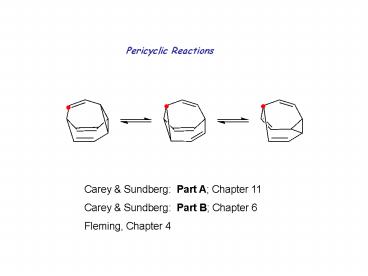Carey - PowerPoint PPT Presentation
1 / 55
Title: Carey
1
Pericyclic Reactions
Carey Sundberg Part A Chapter 11 Carey
Sundberg Part B Chapter 6 Fleming, Chapter 4
2
Pericyclic Reactions Introduction/Definitions
A pericyclic reaction is characterized as a
change in bonding relationships that takes place
as a continuous, concerted reorganization of
electrons.
The term "concerted" specifies that there is one
single transition state and therefore no
intermediates are involved in the process. To
maintain continuous electron flow, pericyclic
reactions occur through cyclic transition states.
More precisely The cyclic transition state must
correspond to an arrangement of the participating
orbitals which has to maintain a bonding
interaction between the reaction components
throughout the course of the reaction.
3
Major Categories of Pericyclic Reactions
4
Major Categories of Pericyclic Reactions
5
Major Categories of Pericyclic Reactions
6
Analysis of Pericyclic Processes
7
Electrocyclic Reactions
8
Electrocyclic Ring Closing/Opening
9
Electrocyclic Reactions Stereochemical
Considerations
It was noted that butadienes undergo conrotatory
closure under thermal conditions, while
hexatrienes undergo disrotatory closure under
thermal conditions. The microscopic reverse
reactions also occur with the same rotational
sense (i.e. cyclobutenes open in a conrotatory
sense when heated, and cyclohexadienes open in a
disrotatory sense when heated.)
10
Molecular Orbitals in Conjugated Systems
11
FMO Treatment of Electrocyclic Reactions
12
FMO Treatment of Electrocyclic Reactions
Photochemical activation
When light is used to initiate an electrocyclic
rxn, an electron is excited from ?2 to ?3.
Treating ?3 as the HOMO now shows that
disrotatory closure is allowed and conrotatory
closure is forbidden.
13
Sigmatropic Rearrangements
14
Sigmatropic Rearrangements
15
1,2 Sigmatropic Rearrangements
16
Sigmatropic Rearrangements
17
Sigmatropic Rearrangements
18
Sigmatropic Rearrangements
1,3
1,5
19
Examples of Sigmatropic Rearrangements/Shifts
20
Sigmatropic Rearrangements
21
2,3 Sigmatropic Rearrangements
22
2,3 Sigmatropic Rearrangements
23
Examples of 2,3 Sigmatropic Rearrangements
24
Coupled 2,3 Sigmatropic Rearrangement/ Reductive
Cleavage
25
2,3 Sigmatropic Rearrangements Transition
State Structures
26
2,3 Sigmatropic Rearrangements in Synthesis
27
Sigmatropic Rearrangements
28
3,3 Sigmatropic Rearrangements
29
3,3 Sigmatropic Rearrangements
30
3,3 Sigmatropic Rearrangements
31
3,3 Sigmatropic Rearrangements
32
3,3 Sigmatropic Rearrangements
33
3,3 Sigmatropic Rearrangements
34
Complex Total Synthesis An Introduction
35
Complex Total Synthesis An Introduction
36
Complex Total Synthesis An Introduction
37
Complex Total Synthesis An Introduction
38
Complex Total Synthesis An Introduction
39
Complex Total Synthesis An Introduction
40
Complex Total Synthesis An Introduction
41
The Claisen Rearrangement
42
Traditional Claisen Rearrangements
43
The Claisen Rearrangement in Cyclic Systems
44
Synthesis of Allyl Vinyl Ethers
45
Other Claisen Variants
46
Other Claisen Variants
47
Introduction to Retrosynthesis
48
Introduction to Retrosynthesis
49
Introduction to Retrosynthesis
50
Introduction to Retrosynthesis
51
Introduction to Retrosynthesis
52
Introduction to Retrosynthesis
53
Introduction to Retrosynthesis
54
Acyclic Chirality Transfer in the Claisen
Rearrangement
55
Acyclic Chirality Transfer in the Claisen
Rearrangement

